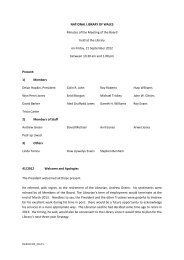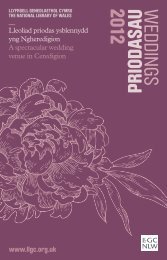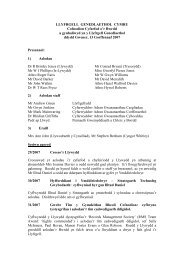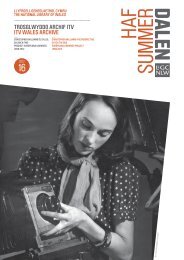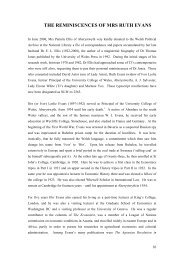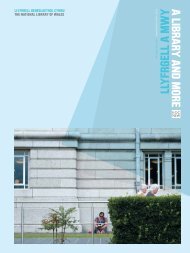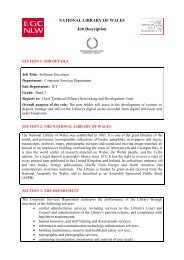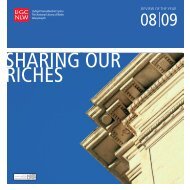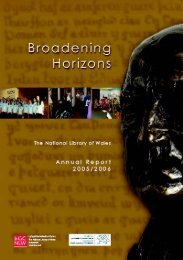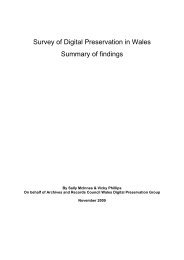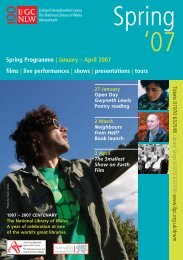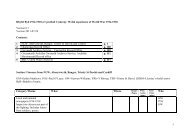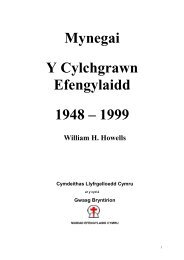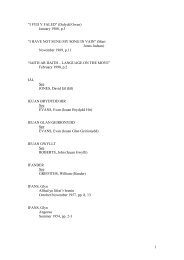Cynhadledd Llandrindod 2009 - adroddiadRhif827[1] - Llyfrgell ...
Cynhadledd Llandrindod 2009 - adroddiadRhif827[1] - Llyfrgell ...
Cynhadledd Llandrindod 2009 - adroddiadRhif827[1] - Llyfrgell ...
You also want an ePaper? Increase the reach of your titles
YUMPU automatically turns print PDFs into web optimized ePapers that Google loves.
Welsh Libraries, Archives and Museums Conference‘Space for all’The Metropole Hotel, <strong>Llandrindod</strong>May 21, <strong>2009</strong>Present from the Library:Barbara Davies, Ann F. Evans, Rhys M. Jones, Hywel Lloyd and Siân Bowyer.(Everyone attended the morning session. Barbara, Ann, Rhys and Siân were in thearchivists’ meeting in the afternoon, whilst Hywel attended the libraries session.)What was learned personally?i. Improvements in facilities and buildings, as well as pioneering onlinework being essential when trying to attract users and safeguardcollections. Increased user numbers and a more positive attitude amongststaff have been noted in some establishments as a result of recentimprovements.ii. The importance of striving to display national collections to the publicacross Wales and expanding standardised networks following thesuccess of the Sharing Treasures scheme.iii. The importance of Wales having an online presence. Like The People’sCollection, that will enable users to search for information and resourceson Welsh culture and heritage. An important step in awakening Welshawareness as well as promoting Wales to others.iv.Interest in seeing if various websites will transfer to operating goodpractice.v. The background, work and collections of the Royal Commission on theAncient and Historic Monuments of Wales. Materials such asphotographs, pictures, architectural drawings and maps are collected, andthere is a new challenge concerning archiving digital material, e.g.80,000 online site registers. The Coflein database is a medium to searcha number of the Commission’s catalogues, and the Historic Walesgateway takes a further step forward, being a means of searchingthousands of records from a number of institutions; National MuseumWales, CADW, The Commission and Archaeological Trusts in Wales.vi.vii.The relevance of the historic environment to, amongst others, tourismand the economy, regional and national identity, and site regenerationwas emphasised.Libraries can offer a neutral environment for communities of foreignworkers, where advice and practical information can be offered, as wellas providing an opportunity to network and integrate with local people.The People’s Network computers being essential for workers fromabroad, e.g. when searching for work, accommodation, and contactingfriends and family at home.What could the Library learn?i. The importance of investing in space, e.g. reading rooms and storage, aswell as virtual space, e.g. online search facilities and digital archiving.ii. The effectiveness of using new space to attract new users.
iii. An online presence is essential for minority nations like Wales in orderthat they aren’t drowned out by larger nations.iv. Relevance can’t be attained without users; there are advantages to begained from showing people how they could use information.v. Benefit can be gained from working with other institutions, e.g. theHistoric Wales online service was developed through a SWISH (SharedWeb Information Services for Heritage) partnership between The RoyalCommission for Ancient and Historic Monuments in Scotland and inWales.vi. Getting to know the local community, diversity of users anddemographic changes, in order to effectively respond to their needs.vii. Providing activities for children is a good way of nurturing interest in theLibrary within the community and of increasing visitor statistics.viii. There is room for libraries, and similar institutions, to support positiveintegration for people within their communities, and it’s essential to trainstaff to work with users and the community.ix.The importance of taking the Library to the people of Wales, andtargeting different groups in order to make them aware of theopportunities it has to offer.x. The importance of marketing and using celebrities to increase awarenessof the Library.Should Library staff attend a similar conference in future?It is very important for the Library to send a regular delegation from differentdepartments and sub-departments to this conference. It is an ideal opportunity to hearabout events and current developments in our specialist fields and within theinformation sector in general; and also to meet and discuss with co-workers fromoutside of our own establishment.AFTERNOON SESSIONSARCHIVESNational Collections Strategy: consultation and next steps(Cathy Smith)• Looking at what is collected, the reasons for collecting, what gaps exist, how oftenthe process is revised, and why and how users access to the collections.• Is there a danger, in the absence of a strategy, that we could stop collecting certaintypes of record?• How far should strategy be developed whilst maintaining independence?• An effort to formalise processes and develop a toolkit to create a collectionsstrategy.• Trying to guess what users will need.• Need to manage the life cycle of records: current records are created hurriedly;emails duplicated by sending them to a number of people; what is the originalrecord?
The new Glamorgan Record Office(Susan Edwards)• Present building dates from the establishment of the archive in 1939; 8km ofarchives in three locations; 610 schools and over a million people in the catchmentarea.• Brand new building – waiting for completion of building work, an idealopportunity to prepare the staff and engender a positive attitude to the newdevelopments.• Four floor storage block; surrounded by a passive environment.• Open plan building design – public areas, store rooms, offices, and a conservationlaboratory under one roof.• Trying to create an informal atmosphere: entrance through two revolving doors,large enquiries desk facing users; relaxed atmosphere in the lobby; loop systemrather than the traditional notice board; glass screen to the search room in orderthat users feel comfortable. Wi-fi throughout the building and a laptop for everymember of staff.• Special flexible room offering better provision for groups. Gradual decline inindividual users but an increase in the number of groups using the service.Discussions with groups inside the archive (relevant documents may also bedisplayed) more effective than going out to address societies.Innovative ways, sustainable means: The Archives Hub's space exploration(Jane Stevenson)• 175 research institutions, mainly, have contributed over 23,000 collection leveldescriptions (fonds) since the service was established in 2000.• Close to 50,000 searches every month and far more hits.• An increase in hits was observed by optimising search engines and changingpages and metadata.• Develop the site content in future: technology, pictures, digital content.• Spokes; individual establishments taking direct control of their data; ‘TheDistributed Hub’.• The Archives Hub being one of the National Archives Network (NAN).Established in 2000 but hasn’t become an interoperable network.• NAN as a community to share information and promote standards and flexiblework practices.LIBRARIESChange management: a view from the baySteve Hardman• I learned about the process of managing change and ensuring that newbuildings continue to respond to users’ needs.• Build staff skills within the establishment because it is too expensive to attractpeople from outside (especially in times of recession).• The importance of providing a service for children in libraries in order toencourage their continued use in future.• Customers need to be cared for and information should be presented in themost effective manner. Knowing the community that is served is valuable.
Amrywedd yn y <strong>Llyfrgell</strong> Genedlaethol – Diversity in the National LibraryArwel Jones• There are four reading rooms in the National Library; Print, Unique, Screenand Sound Archive and the Education Room.• The average age of readers has fallen in recent years. Many come to theexhibitions and as customers to the shop, as well as using the reading rooms.Visitors participate in more than one of the above activities and thereforeexpand their experience of the Library.• 2 million pounds was given to digitize newspapers. This was partially fundedby JISC in order to give users access to the collections in their own homes. Itwas noted that accessing collections through the internet gave equalopportunity to all, and gave opportunities for those suffering from physicaldisabilities that would not otherwise be able to come to the library and use thecollections. This solves one of the fundamental problems the library faces,being out of the way and hard to reach for many.• Another difference by now apparent in the Library is that the staff are using awider variety of skills. Previously a librarian’s work had mainly involvedcataloging; by now computer technologies like Web 2.0 are being used toenable users to post comments on the collections that will help other users.Flickr and YouTube are also being used to share information.• New technology is also being used in the building, with kiosks and juke-boxesimproving the visitor experience. The Library’s core role is to collect and keepmaterial. The staff must be flexible and adapt to the requirements of the age.Promoting your space for allJane Purdie a Nicola Williams• The importance of marketing to attract users to libraries.• The effectiveness of celebrities in doing this and in giving books and librariesa good name.


![Cynhadledd Llandrindod 2009 - adroddiadRhif827[1] - Llyfrgell ...](https://img.yumpu.com/51129644/1/500x640/cynhadledd-llandrindod-2009-adroddiadrhif8271-llyfrgell-.jpg)
